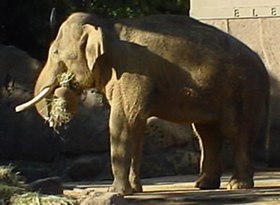Elephas – Wikipédia, a enciclopédia livre
| Elephas | |||||||||||||
|---|---|---|---|---|---|---|---|---|---|---|---|---|---|
| Ocorrência: Plioceno à atualidade 3,5–0 Ma | |||||||||||||
| Classificação científica | |||||||||||||
| |||||||||||||
| Espécies | |||||||||||||
| Sinónimos | |||||||||||||
| |||||||||||||
Elephas é um dos dois gêneros sobreviventes da família dos elefantes, Proboscidea, com uma espécie sobrevivente, o Elefante-asiático (Elephas maximus).[1]
Várias espécies extintas foram identificadas como pertencentes ao gênero, incluindo Elephas recki, Elephas antiquus, e os elefantes pigmeus Elephas falconeri e o Elephas cypriotes. O gênero está intimamente relacionado ao gênero de mamutes Mammuthus.[2]
Taxonomia[editar | editar código-fonte]
Elephas é atribuída à família dos proboscídeos Elephantidae que inclui uma espécie viva e 10 extintas:[3]
- Elephas maximus (Elefante-asiático);[1]
- Elephas maximus indicus (Elefante-indiano)
- Elephas maximus maximus (Elefante-do-ceilão)
- Elephas maximus sumatranus (Elefante-de-sumatra)
- Elephas maximus borneensis (Elefante-pigmeu-de-bornéu)
- †Elephas maximus rubridens (Elefante-chinês)
- †Elephas maximus asurus (Elefante-sírio)
- †Elephas beyeri — Descrito a partir de fósseis encontrados em 1911, em Luzon, Filipinas por von Königswald;[4]
- †Elephas celebensis, Elefante-pigmeu-de-celebes — fósseis encontrados ao sul de Celebes, Filipinas por Hooijer em 1949;[5]
- Elephas ekorensis — Descrito a partir da Formação Kubi Algi, Turkana, Quênia;[3]
- †Elephas falconeri — Descrito a partir de fósseis encontrados em Malta (ilha) por Busk in 1867;[6]
- †Elephas hysudricus — Descrito a partir de fósseis encontrados em Sivalik, Índia por Falconer e Cautley, 1845;[7]
- †Elephas hysudrindicus — É um elefante fóssil do Pleistoceno de Java, Indonésia é diferente do Elephas maximus;[8]
- †Elephas iolensis
- †Elephas planifrons
- †Elephas platycephalus
- †Elephas recki;[9][10]
Referências
- ↑ a b Shoshani, J. (2005). Wilson, D.E.; Reeder, D.M. (eds.), ed. Mammal Species of the World 3 ed. Baltimore: Johns Hopkins University Press. p. 90. ISBN 978-0-8018-8221-0. OCLC 62265494
- ↑ Fleischer, R. C.; Perry, E. A.; Muralidharan, K.; Stevens, E. E.; Wemmer, C. M. (2001). Phylogeography of the Asian Elephant (Elephas maximus) based on mitochondrial DNA Arquivado em 17 de março de 2012, no Wayback Machine.. Evolution 55(9): 1882–1892
- ↑ a b Maglio, V.J. (1973). Origin and evolution of the Elephantidae. Transactions of the American Philosophical Society Philadelphia Volume 63. American Philosophical Society, Philadelphia. Pp. 149
- ↑ Von Königswald, G. H. R. (1956). Fossil mammals from the Philippines. National Research Council of the Philippines, Manila
- ↑ Hooijer, D.A. (1949). Pleistocene Vertebrates from Celebes. IV. - Archidiskodon celebensis nov spec.. Zoologische Mededelingen Museum Leiden, 30 (14): 205–226.
- ↑ Busk, G. (1867). Description of the remains of three extinct species of elephant, collected by Capt. Spratt, C.B.R.N., in the ossiferous cavern of Zebbug, in the island of Malta. Transactions of the Zoological Society of London, 6: 227–306.
- ↑ Falconer, H. Cautley, P. T. (1846). Fauna Antiqua Sivalensis, Being the Fossil Zoology of the Sewalik Hills. Smith, Elder & Company, London. Pp. 64.
- ↑ Hooijer, D. A. (1955). Fossil Proboscidea from the Malay Archipelago and the Punjab. Zoologische Verhandelingen, 28 (1): 1–146.
- ↑ Todd, N. E. (2001). African Elephas recki: Time, space and taxonomy. In: Cavarretta, G., Gioia, P., Mussi, M. and M. R. Palombo. The World of Elephants, Proceedings of the 1st International Congress. Consiglio Nazionale delle Ricerche, Rome, pp. 693–697.
- ↑ Todd, N. E. (2005). Reanalysis of African Elephas recki: Implications for time, space and taxonomy. Quaternary International Volumes 126–128: 65–72.


 French
French Deutsch
Deutsch